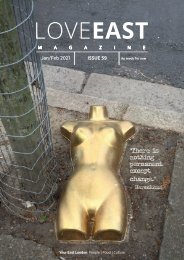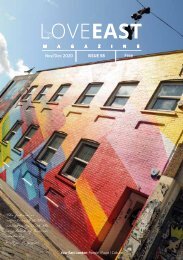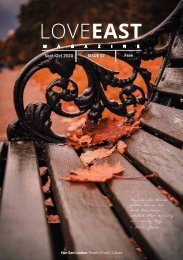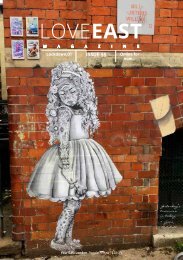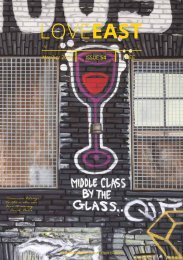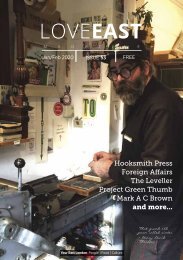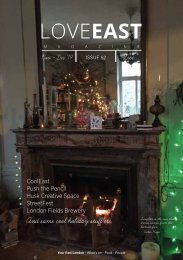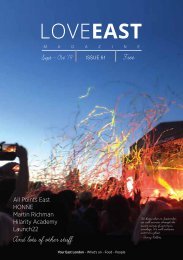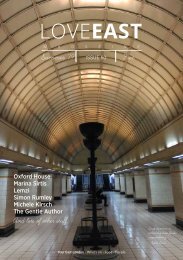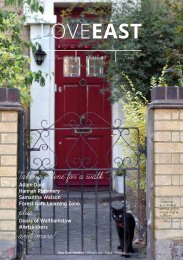Create successful ePaper yourself
Turn your PDF publications into a flip-book with our unique Google optimized e-Paper software.
WalkHackney's Sean Gubbins on<br />
Well-Watered Hackney<br />
As this year’s summer may turn out to be the driest<br />
ever, perhaps we will take less for granted water, which,<br />
after all, gave Hackney its name. At the end of an<br />
English place name ‘ey’ denotes a watery connection<br />
viz. Ely, Lundy, Sheppey. Hackney’s coat of arms has<br />
around it a border of waves representing the borough’s<br />
waterways, principally the River Lea, London’s second<br />
largest river which forms Hackney’s eastern border.<br />
We have Shaclkewell, Well Street and, in Shoreditch,<br />
Holywell Lane, close by what were St Agnes le Clair<br />
wells, off Old Street. These wells were tapped for ale<br />
brewing, though not, one hopes, at the<br />
same time as they were “frequented”,<br />
according to John Stow in 1598, by the<br />
“youth of the city in summer evenings,<br />
when they walk forth to take the air.”<br />
Stamford Hill is named after a sandy<br />
ford used to cross the Hackney Brook,<br />
which flowed along the line of today’s<br />
Grazebrook Road. Stonebridge Common is<br />
where a small stream was crossed which,<br />
for some distance, ran east as a boundary<br />
between Hackney and Shoredicth<br />
parishes. Ponsford Street is a renaming of<br />
Bridge Street, which took folk south out<br />
of Homerton, across the Hackney Brook.<br />
Spring Hill runs beside Springfield Park,<br />
where sometimes springs still bubble up.<br />
The Hackney Brook, which flowed from<br />
its source in the hills of north London to the Lea<br />
at Hackney Wick, had disappeared into London’s<br />
underground sewage system by the 1860s. At times it<br />
could flood to 70 foot, be two feet deep and was the<br />
site of more than one tragic drowning. As it flowed<br />
through its valley at the bottom of Clissold Park, it<br />
was used to fill ornamental lakes. Following its course<br />
downstream can still be seen, at the north-east corner<br />
of Abney Park Cemetery, the mound now no longer<br />
surrounded by water but once an islet where the<br />
divine, Dr Issac Watts, would contemplate.<br />
Also running through Hackney are two man-made<br />
waterways. The oldest is the New River, completed in<br />
1613, to bring water from Hertfordshire to the growing<br />
City of London. Meandering along the 100 foot<br />
contour, it flowed into Clissold Park, on a ridge above<br />
the Hackney Brook, and then followed a sharp bend<br />
One of the ornamental lakes,<br />
once fed by the Hackney<br />
Brook, in Clissold Park.<br />
A New River Company plaque<br />
which can still be seen in<br />
some roads.<br />
History<br />
west again to flow out towards the New River Head in<br />
Islington. Two hundred years later the Regent’s Canal<br />
was dug through the fields of Haggerston. South of<br />
London Fields, it is crossed by the Cat and Mutton<br />
Bridge. The bridge existed before the canal, spanning<br />
one of the many streams that criss-crossed wellwatered<br />
Hackney. The stream ran down the side of<br />
London Fields but was drained with the coming of the<br />
canal. Another stream was the Pigwell, which emerged<br />
near Dalston Junction and ran along the south side of<br />
today’s Graham Road, to join the Hackney Brook.<br />
Today we can enjoy the open waters<br />
of Stoke Newington’s East and West<br />
Reservoirs because in the 1980s local<br />
campaigners successfully fought off plans<br />
to develop them for housing. Constructed<br />
in the 1830s (some say lined with the stone<br />
of old London Bridge), they were to store<br />
water before it was pumped by the New<br />
River Company to be filtered prior to<br />
distribution.<br />
The New River Company supplied water<br />
for homes in the western parts of Hackney<br />
and Stoke Newington. Still to be seen on<br />
a few roads are the plates bearing the<br />
NR stamp. The east of the borough was<br />
supplied by the East London Waterworks<br />
Company. They took over an earlier<br />
operation which had constructed a<br />
reservoir, now know as Clapton Pond, to hold water<br />
pumped from the Lea.<br />
When the rains come this summer and challenge<br />
Thames Water’s drainage system, maybe water will<br />
flood once more across the road at the bottom of the<br />
Narrow Way. It won’t be the Hackney Brook breaking out<br />
from its conduited confinement. But it will be a reminder,<br />
as the water congregates in the valley of Hackney’s river,<br />
of what once flowed through these parts.<br />
Looking for something to do one weekend?<br />
Intrigued to find out more about Hackney?<br />
Look up walkhackney.co.uk and pick a walk<br />
that takes your fancy. The next two are in this<br />
edition's What's On section. I look forward to<br />
welcoming you on one of my walks.<br />
LOVEEAST AUGUST - SEPTEMBER 2018 31<br />
Images courtesy of Sean Gubbins



